In dealing with multimediality and multimedial texts we are often struck by the fact that thick layers of meanings tend more and more to grow around words such as media, multimedia and multimedial communication. But it seems clear by now that the word Multi ─ more than one ─ does not really tell us much about the relations among the 'things' that are somehow joined together, or about those things themselves. Neither it does the word Media, whose definition has more and more assumed a sort of umbrella-like character, since it contains many different and often incompatible sub-definitions which easily confuse the reader.
If we want to understand in a more proper way the meaning of such a words, and if we want to have a clearer picture of their use in multimedial communication, we need then to 'go back to the roots' and try to re-think about them and maybe re-define them, especially during a time in which multimediality has to find its place in a world shaped by the new concepts of hyper-mediality, poli-mediality and tele-mediality.
We can distinguish at least three reasons for the umbrella-like character of the definition of media.
A) First of all, we must think that the definition of media is always a function of the context within which it is used. People operating within a particular context tend to include into their definition only those features which have proved themselves to be useful, and, consequently, to exclude form such a definition those features which, within that particular context, are meaningless for the users. If, for example, somebody's interests are mostly oriented toward the use of a medium ─ let's say the cinema ─ for artistic purposes, s/he does not really have to care too much about the technical problems connected to the construction of a movie-device such as a video camera. And this, of course, determines/modifies his/her understanding of what the medium 'cinema' is (and, as we will see later, also his/her understanding of what that medium can/cannot do).
We can identify four main contextually given areas of definition of media:
- the Macro-Social area: people working in this sector are mainly concerned with the relationships between media and society. They investigate the sociological, economical and political consequences due to the introduction of the media into society;
- the Psychological area: here the main focus is the understanding of the psychological effects of the media on the users/consumers.
- the Artistic area: in this field, the main concern of those who use media is about the production and the reception of media thought as works of art.
- the Linguistic area: scholars working in linguistics and semiotics are mostly concerned with the structural analysis of the forms of media and of their contents.
B) The definition of media depends not only on the particular context within which the media are used, but also on the culture which uses them. Different cultures might use the 'same' medium in the 'same' context (one of the four main areas we have identified in (A)) in a different way and according to different needs, and therefore might have two different definitions of that medium.
C) The definition of media has a strong historical character. This means that one particular medium used by one culture in the 'same' context, but in two different historical times, can have two different (and sometimes contradicting) definitions.
From what we have seen it should then be clear that a general definition of media has to account for the presence and the co-existence of all the possible sub-definitions which are historically, culturally and contextually given, and which are therefore subjected to be changed.
In order to reach the core of our definition, we must then take into account the following important (although apparently taken for granted) fact: if we deal with media we inevitably have to deal with communication, too. This means that we also have to deal with some physical 'objects' (the 'texts' or the physical manifestation of the 'texts') that are created (at a certain time, in a certain place, and in a given context) by somebody (an individual historically and culturally characterized) and transmitted through the medium/a to somebody else (another individual historically and culturally characterized, too).
All this has some important consequences in the shaping of the definition we look for:
- we cannot find an adequate definition of what media are without considering one adequate model of the process of communication. By using this model, we must also try to create a typology of communicative situations which (ideally) accounts for all the possible types of communicators and of all the possible (culturally and historically given) situations within which the media can be used.
- before understanding what media are we must also have a clearer idea of what the 'objects' (the 'texts') transmitted by the media are; therefore, we need to construct a typology of 'texts' which (ideally) should account for all the possible elements/matters these texts are made of, and all the possible ways the different elements/matters are combined in complex chains.
- once we possess the typology of communicative situations and of texts we must analyze the complex processes which account for the 'transmission' of the 'texts' from one given communicator-place-time to another given communicator-place-time, that is, we must:
- create a model which accounts for the 'transmission' of some pieces of information through one medium;
- create, on the basis of this model, a typology of mono-media (media which make use of only one kind of 'matter'/'language').
- create a model that accounts for the ways the mono-media interact together in a multimedial text.
The goal of this brief paper is to present an outline of the problems connected with the definition of media. Therefore, we cannot deal here with the typology of communicative situations and with the typology of texts; so we will limit ourself to present a synthesis of point (3.i). (It should be clear, however, that a more detailed investigation toward the definition of media cannot be carried out without having previously constructed the above typologies.)
Assuming that we have already constructed our typologies, we can now continue by giving that definition of media (or, from now on, it should be more proper to speak about a medium, or rather, a technical medium; the difference between technical and non-technical media will be discussed later) which should be the goal of our research:
a technical medium is a configuration of inter-connected structures which are instantiated (physically builded) on particular supports/devices. They allow the acquisition of certain chains of physical elements (related to some states of affairs in the world); these chains of elements are transported, stored, re-transported, and exposed. During the processes of transportation, storage, and exposure the original elements and their original order (and, therefore, their relations to certain states of affairs) can be transformed into new physical elements and can be connected together in a new order, so that they become the physical manifestation of a new text which can be used in a possible communicative process.
We can try to reach the understanding of this complex definition by examining some figures. First of all, as we have already said, we need to place the medium within a communicative situation. Figure 1 shows the classical (and oversimplified) model of communicative situation.
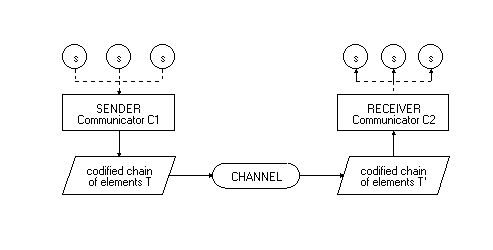
Figure 1
Given two Communicators in a certain communicative context, the Communicator C1 (the Sender) will take some states of affairs from the 'world' he has knowledge of, and, according to some conventional systems of rules, he will associate these states of affairs to a chain of physical elements. This chain of elements will goes through a CHANNEL from the Sender to the Communicator C2 (the Receiver), who, on turn, according to one or more conventional systems of rules, will be able (if he desires so) to connect the received elements to some states of affairs in the world he has knowledge of.
We are not interested now in knowing any of the features characterizing the two communicators, the context of communication, or the systems of rules relating states of affairs in the world to sets of physical distinct elements. It is the channel to focus our attention. In the model presented in Figure 1, the channel is supposed to be just a neutral means of transmission of the codified chain of elements. But if we want to deal with the definition of media we are forced to abandon this naive conception of channel. Figure 2 shows the attempt at making a first distinction between channels and media.
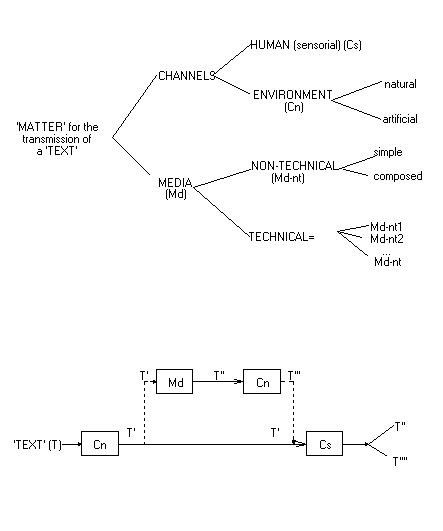
Figure 2
According to this figure, the means (or maybe the 'matter') which allows the transmission of physical chains of elements can be 'divided' into two types: the channels and the media. The channel (either human (sensorial) or present in the environment) should be seen as that physical (and rather inevitable) means/'matter' which allows the passage/transmission of physical chains of elements without altering them. Of course, this statement is rather strong, and surely problematic, since it dangerously asks for a more precise definition of the concept of alteration. The only thing we can say here is that the distinction has been make for the sake of simplification. Taking for granted that a form of alteration is always inevitable during an exchange of whatever kind of information, we should maybe reformulate the previous statement as follows: a channel is that physical means/'matter' which alters a transmitted physical chain of elements in a non-relevant way, so that the states of affairs related to the original chain of elements and the states of affairs related to the transmitted chain of elements can be thought to be same. (If we look again at Figure 2 we can see that a further distinction between non-technical and technical media has also been made. It is not possible to examine in detail here the reasons for this differentiation; anyway, it should be enough to say that the non-technical media are thought to be the 'natural' or 'almost-natural' means of communication. According to this definition, the non-technical media can even be identified with the verbal, paraverbal and non-verbal languages.)
It is easy to see at this point that a first, yet unshaped, definition of technical medium emerges by contrast, as a consequence of the distinction presented above:
A technical medium is that means/matter used in a communicative process which alters in a peculiar and evident way the chain of elements (and therefore their relations to some states of affairs in a certain world) which goes through it.
In this sense, we can think of a technical medium as a sort of filter which manipulates chains of physical elements (together with their meanings). If we call (in a rather vague and general sense) 'Text' that chain of physical elements related to some states of affairs in at least one possible world, than we can see in Figure 3 a more detailed model of what in Figure 1 was called 'channel'.
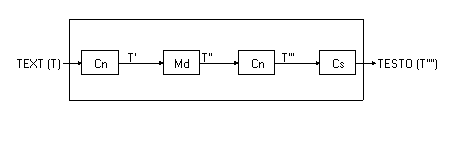
Figure 3
In order to reach the receiver, the 'text' (T) passes through one or more channels (Cn) (as defined in Figure 2) and it is (theoretically speaking) altered (in the sense we have considered before) so that it becomes a new text (T'). T' goes through a major change when is filtered by the medium (Md), and becomes a new text T'', which is again 'altered' when it passes through new channels (Cn –>T''', Cs –> T''''). Even if, on the basis of what we have previously said, we can consider as non-relevant the changes in Cn and in Cs, we still have to account for the changes which a text goes through when it is filtered by a medium Md.
Figure 4 shows in a more detailed way what happens when the text is 'filtered' by Md.
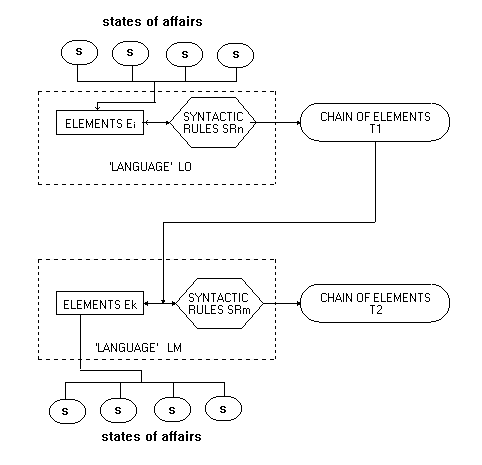
Figure 4
If we recall the distinction between non-technical and technical media, we can read the figure as follow: we consider the set of elements Ei (related to some configurations of states of affairs in at least one possible world) together with a system of syntactic rules (SRn) as a language-object (LO) (or a natural/almost-natural medium). By means of the syntactic rules we can combine the elements Ei in structured chains. These chains (T1) (a 'text' produced by a natural medium) can be taken as elements belonging to another language (LM) (the language used by a technical medium) and manipulated by its system of syntactic rules (SRm) so that to produce new chains of elements (T2) (a new 'text') related to some configuration of states of affairs in at least one possible world.
Figure 5 shows more clearly the processes of manipulation of the physical manifestation of a text (together with its meanings). In general, we can say that Figure 5 describes the structural organization of a whatsoever kind of medium. We should think of each medium as a configuration of codified structures (which, all together, can be thought as the 'grammar' of the medium) which are created in order to make the communication possible (that is, these structures exist independently from concrete communicative functions/purposes; they make it possible to communicate). Each of those structures is a set of elements organized according to some syntactic rules. In a concrete working medium each structure is physically realized by one or more physical devices fulfilling a needed function.
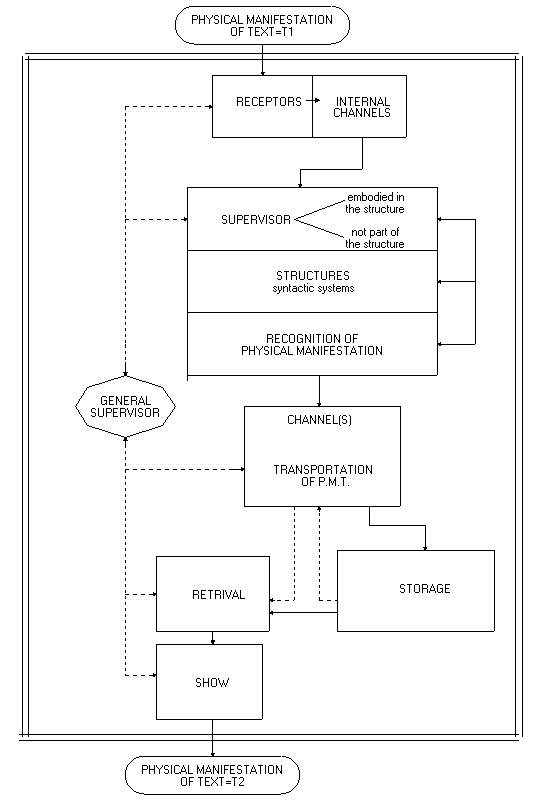
Figure 5
More in particular, the whole 'filtering' process of a 'text' carried out by a medium can be divided into several steps:
- acquisition of the chains of elements constituting the physical manifestation of the incoming 'text';
- transportation of the acquired elements by means of internal channels;
- 'recognition' of the elements and classification;
- reorganization of the acquired physical elements and of their sequence (and, consequently, of their meaning) according to the sets of rules codified into some internal structures;
- storage into an internal area working as a memory;
- re-transportation from the memory to an area used for the exposition of the new elements organized into new chains;
- exposition by means of some particular device.
Many other things should be said at this point. As we have already mentioned, the study of the structural organization of a medium is only the first step toward the definition of multimediality. The model in Figure 5, together with the information we (should) have gained about all the possible communicative situations and all the possible texts, should allow us to create the typology of mono-media we are looking for. But it is only through the construction of a different model (impossible to present here) that we can examine the ways the different mono-media work together in a multimedial text. That model would help us to get closer to a more complete definition of media and, consequently, of multimediality and multimedial communication. But ,of course, the task is beyond the goal of this paper and has to be fulfilled only with a more detailed research. |
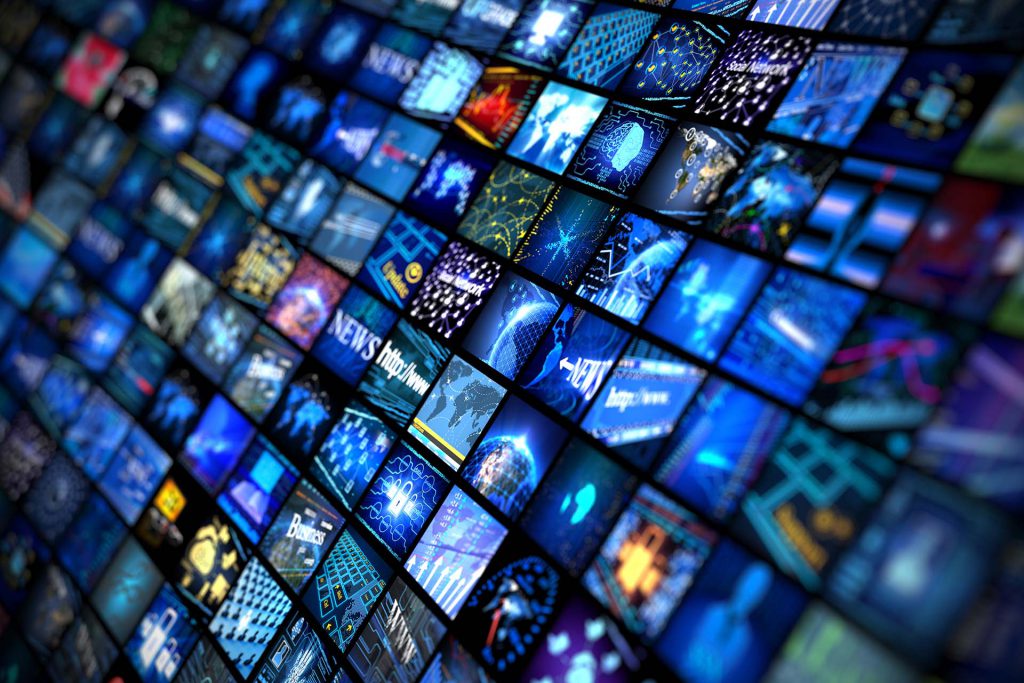
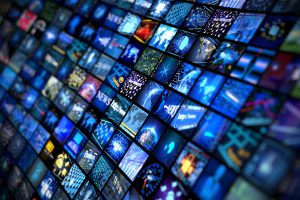
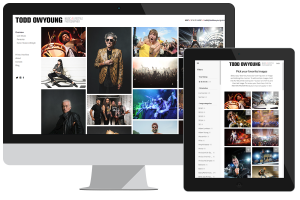
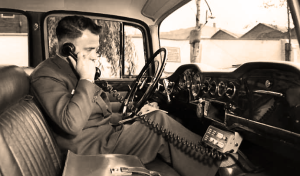
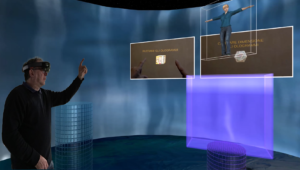
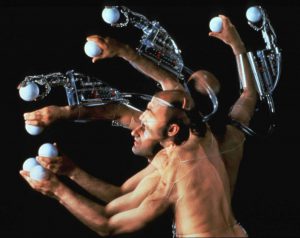
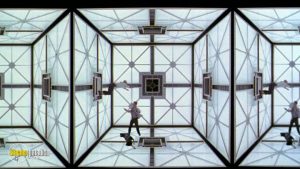
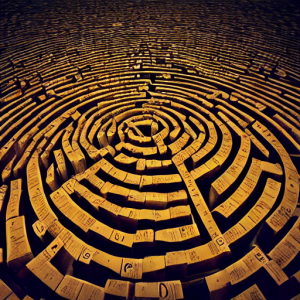
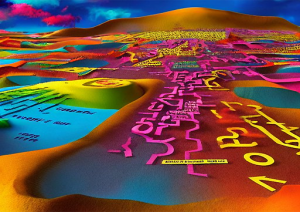


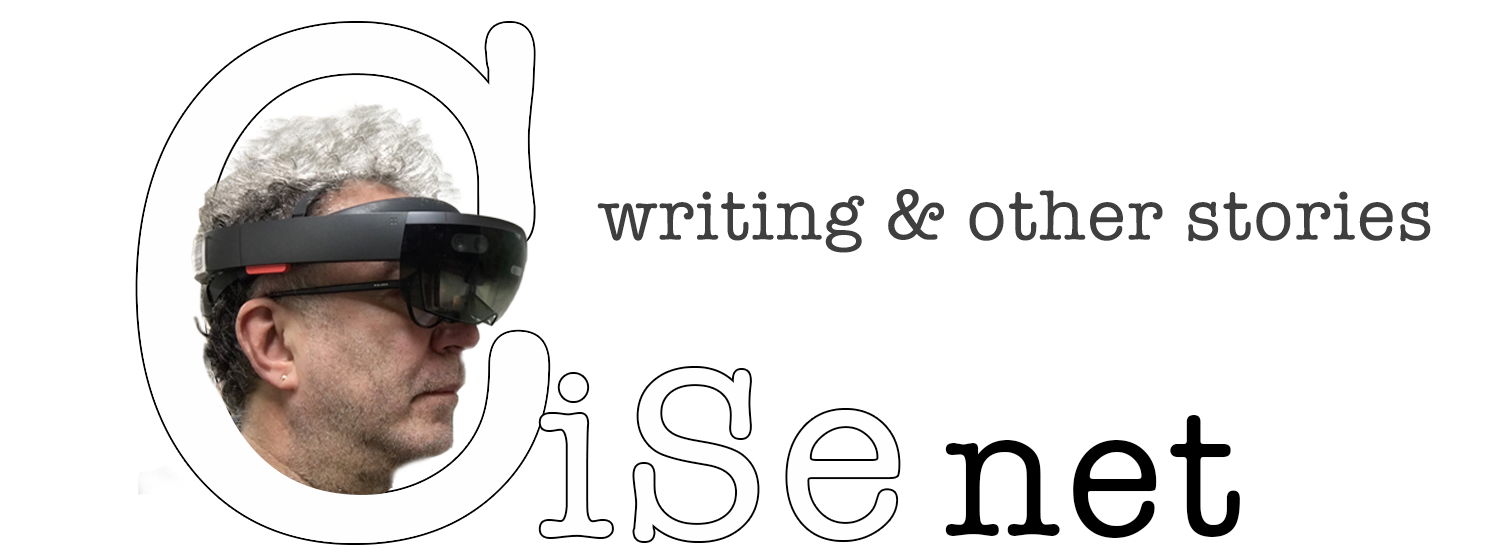
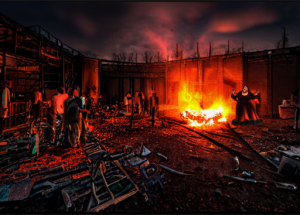

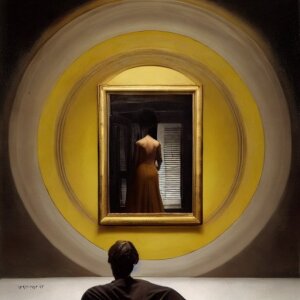
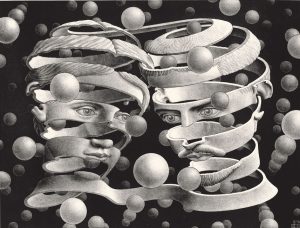

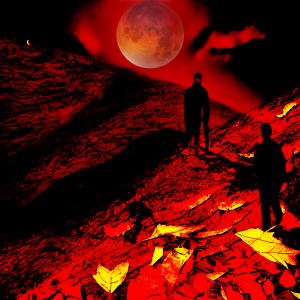

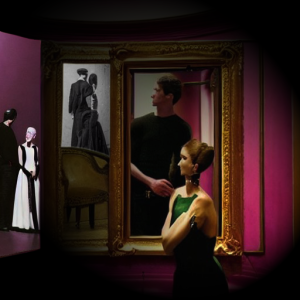





Leave a Reply